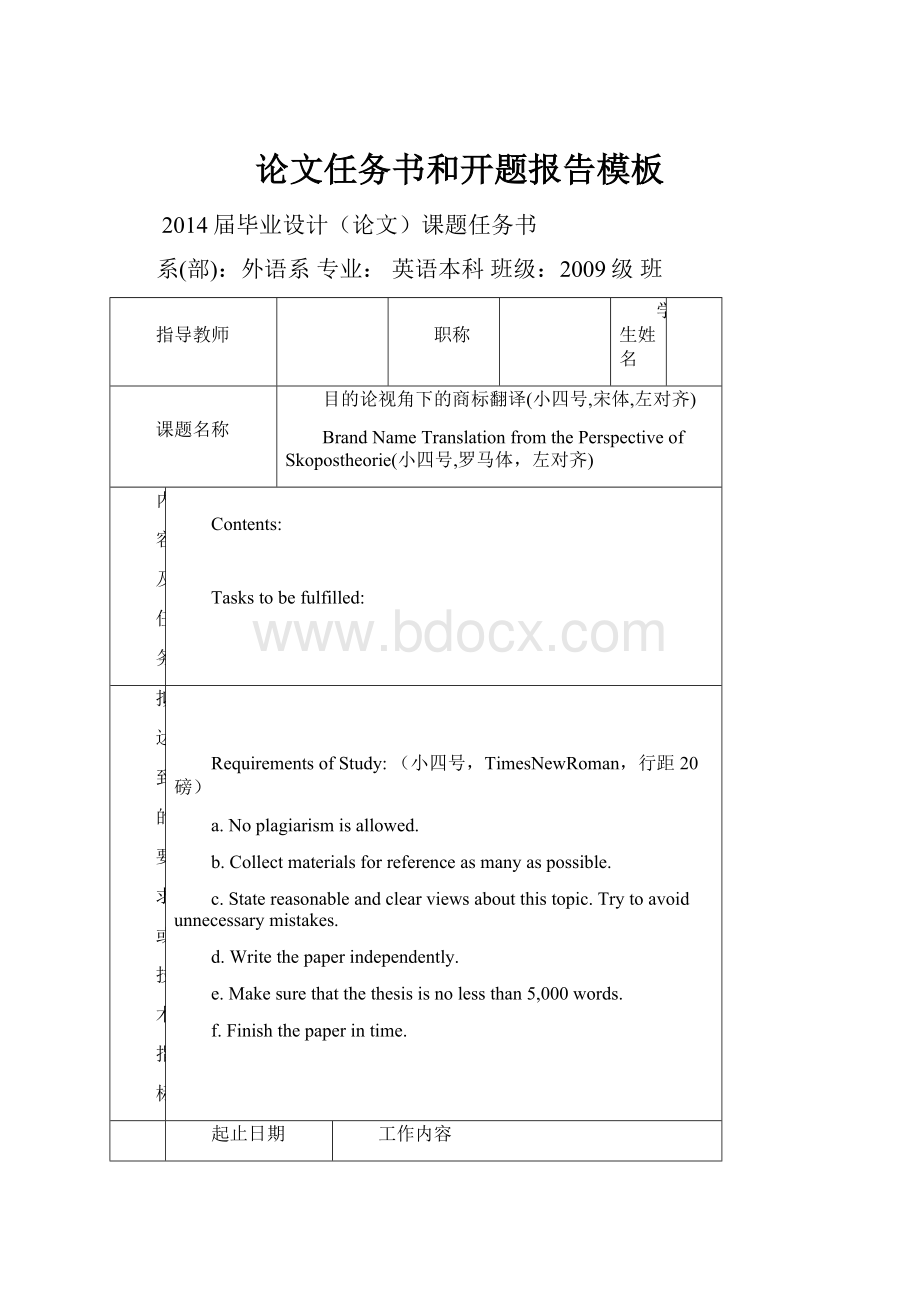论文任务书和开题报告模板.docx
《论文任务书和开题报告模板.docx》由会员分享,可在线阅读,更多相关《论文任务书和开题报告模板.docx(12页珍藏版)》请在冰豆网上搜索。

论文任务书和开题报告模板
2014届毕业设计(论文)课题任务书
系(部):
外语系专业:
英语本科班级:
2009级班
指导教师
职称
学生姓名
课题名称
目的论视角下的商标翻译(小四号,宋体,左对齐)
BrandNameTranslationfromthePerspectiveofSkopostheorie(小四号,罗马体,左对齐)
内
容
及
任
务
Contents:
Taskstobefulfilled:
拟
达
到
的
要
求
或
技
术
指
标
RequirementsofStudy:
(小四号,TimesNewRoman,行距20磅)
a.Noplagiarismisallowed.
b.Collectmaterialsforreferenceasmanyaspossible.
c.Statereasonableandclearviewsaboutthistopic.Trytoavoidunnecessarymistakes.
d.Writethepaperindependently.
e.Makesurethatthethesisisnolessthan5,000words.
f.Finishthepaperintime.
进
度
安
排
起止日期
工作内容
2013年10月23-31日
向学生公布毕业设计(论文)课题,并组织好学生选好或确定好指导教师及课题。
2013年11月3~6日
公布选题结果。
2013年12月4~10日
下达任务书,指导学生写作开题报告。
2014年2月17~21日
学生提交、修改开题报告。
2013年3月14日前
完成论文初稿,交指导老师。
2014年3月28日
论文中期检查,交中期报告。
2014年4月25日前
学生交论文定稿,指导老师评阅表,评阅老师评阅表,答辩评审表。
2014年4月30日
论文答辩,评定论文成绩,学生根据答辩修改论文。
2014年5月9日
根据答辩委员会意见修改论文,提交白色铜版纸封面的毕业论文最终稿,提交毕业论文电子文档
主
要
参
考
资
料
[1]Reiss,K.&VermeerH.GroundforaGeneralTheoryofTranslation[M].Tubingen:
Niemeyer.1984.
[2]Vermeer,H.J.AFrameworkforaGeneralTheoryofTranslation[J].LebendeSprachem.1978,
(1):
99-102.
[3]安亚平.中国品牌产品商标词译名分析及其翻译方法[M].上海科技翻译,2004,(3):
43-46.
[4]包惠南.文化语境与语言翻译[M].北京:
中国对外翻译出版公司,2001.
[5]代荣.目的论与商标翻译[D].上海海事大学,2006.
[6]李媛.商标词及其翻译探讨[D].广西大学,2007.
[7]梁晓冬.民族心理差异与商标翻译[J].上海科技翻译,1997,(3):
23-25.
[8]苏淑惠.广告英语的文体功能与翻译标准[J].外国语,1996,
(2):
51-54.
[9]王瑞华.试论商标名称的翻译原则与机制[D].人文社会科学学院,2005.
[10]王向华.商标翻译策略[D].山东师范大学,2003.
研室
意见
签名:
年月日
系(部)主管领导意见
签名:
年月日
注:
本任务书一式三份,由指导教师填写,经教研室审批后一份下达给学生,一份由指导教师保留,一份交系部存档。
长 沙 学 院
本科毕业设计(论文)开题报告
(2014届)
系 部:
外语系
专业:
英语
学生姓名:
班级:
学号
指导教师姓名:
职称
2014年2月日(填17-22)
题目:
目的论视角下的商标翻译(宋体,小四号,左对齐)
BrandNameTranslationfromthePerspectiveofSkopostheorie(罗马体,小四号,左对齐)
1.结合课题任务情况,查阅文献资料,撰写1000字以上的文献综述。
WithChina’sentryintoWTOandthetrendofeconomicglobalization,Chinesebusinesshasbeenundergoingever-frequentexchangeswiththeoutsideworld.Moreandmorebusinessesaroundtheworldsparenoefforttomarkettheirproductsorservicesintheworldmarketplaceandtobuildtheirbrandimagesonaglobalbasis.Toenteranewmarket,theyinvestmuchinbranding,amongwhichbandnamesreceiveincreasingattention.Namingcanbecrucialtobusinesses.Agoodbrandnamecanbringaboutunexpectedadvantageswhileabadonecanjeopardizethebusinesses.Soisthecasefortranslatedbrandnames.Awell-translatedbrandnamecanadjusttolocalmarket,cultural,andlegalenvironments,reflectbrandimage,andconveyproductinformation.Whileabadlytranslatedbrandnamecanonlyevokeunfavorableassociationtocustomers,andtheimageofthebusinesswillsuffer.SoCarryingonstudiesinthisfieldisofgreatimportanceandcanhelptoimprovethecompetitivenessofChineseproductsintheinternationalmarket.
Asurveyofarticlesconcerningbrandnametranslationinthepastdecadeshowsthattherehasbeenasteadilyincreasinginterestinthisfieldofstudy.Theresearchcoversawiderangeoftopics,whichcanbeputintothefollowingmajorcategories:
1.Methodsofbrandnametranslation.
NowadaysthereexistvariouswaystotranslateforeignlanguagebrandnamesintoChineseones.WangXianghua(2003)pointsoutfourkindsofmethodsofbrandnametranslation.Inhisessay,hesays“Transliterationisdonemainlyaccordingtothepronunciation.Literaltranslationattachesgreatimportancetotheloyaltyoftherenderingtotheoriginalmeaningwhilefreetranslationpaysmoreattentiontotheacceptabilityoftheversionbythereceptors.CoinedtranslationistomakefulluseoftheimaginationtocreateaconstruingonthebasisoftherelevantSLtext.”WhileWangRuihua(2005)addsanothertwokindsofmethodsofbrandnametranslationinhisessay:
semantictransliterationandcreativetranslation.“SemantictransliterationshouldbethefirstchoicetobemadeintranslatingtheloadwordsintoChinese,”observesHuQingping,“Itisfarbetterthanthemeretransliterationorfreetranslation”(2001).Asforcreativetranslation,hegivesagoodexample:
DutchLady[milkpowder]isputinto“子母粉”.Thistranslatedversion,fromtheviewpointofChineseconsumers,isloadedwiththeculturalmessageofmother’sloveforthechild,whichisthesameaswhatDutchLadymeanstoSLreaders.
2.Principlesofbrandnametranslation.
Asfortheprinciplesofbrandnametranslation,WangRuihua(2005)considersthefollowingprinciplesapplyingtoagoodtranslatedbrandname.Thefirstisavoidingwordswithadverseornegativemeanings.Thesecondisattendingtowordswithdifferentassociationsindifferentcultures.Thethirdisselectingsimpleandplainwordseasytopronounceandmemorize.LiGuisheng(1996:
2)proposesthreekindsof“faithfulness”,namely,faithfulnesstopronunciation,faithfulnesstomeaningaswellasfaithfulnesstomarketingstrategies.LiuQuanfu(1996:
2)holdsthatprincipleofequivalenceshouldbeadoptedinbrandnametranslationwhileXuJinqi(2002:
11)notonlyagreeswithhimonthispointbutalsoaddsanotherprinciple–“beautyinsense,form,andsound”.
3.Culturalfactorsinbrandnametranslation.
Cultureplaysanimportantroleinbrandnametranslation.Somearticleshavetouchedupontheimportanceofcultureinbrandnametranslation.CaoWenwen(2009:
7)putsforwardsthreeaspectsofculturaldifferences:
first,differencesinconnotation;second,thewordschosenhavenegativemeaningsinthetargetculture;third,differencesinusage.LiangXiaodong(1997:
3)isparticularlyinterestedinthetreatmentofnationalpsychologyinthetranslationofbrandnames.Besides,CangLanju(1999:
1)considersitnecessarytotakeintoaccountconsumerpsychology,productnature,concisenessoftranslation,andtargetcultureinbrandnametranslation.
Thedevelopmentofinternationaleconomygivesbirthtobrandnametranslation.Nowadays,Chinesecompanieshavedeeplyinvolvedinafiercecompetitionintheglobalmarket.Welltranslatedbrandnamescanhelptobuildgoodproductimageamongconsumers,whohavebecomemoreandmorecriticalinchoosingproductsoftheirfavoritebrands.Brandnametranslationhasbeenstudiedbymoreandmorescholars.Andthestudiesonbrandnametranslationhavemadeagreatprogressduringthepastdecadeandareofgreattheoreticalvalueforthestudieslateronthisfield.Butlimitationsandshortcomingsalwaysexist,forexample,manyofthediscussionsareconfinedtothemeredescriptiveanalysisofexamplesandhavetoomuchrepetitionorsimilarityinexamplesaswellasintheirexplanationsandtranslationtechniquesandmethodsputforward.Thelackofcreativenessisanotherreasonthathindersthecomprehensivedevelopmentinthisfield.Thediscussionsofculturearealsolackoftheguidanceandsupportofsystematictheories.Sofuturestudiescallfornewperspectivesandmoresystematicandin-deptheffortsonthetopic.
References:
[1]Vermeer,HansJ.AFrameworkforaGeneralTheoryofTranslation[J].LebendeSprachem.1978,
(1):
99-102.
[2]安亚平.中国品牌产品商标词译名分析及其翻译方法[M].上海科技翻译,2004,(3):
43-46.
[3]包惠南.文化语境与语言翻译[M].北京:
中国对外翻译出版公司,2001.
[4]代荣.目的论与商标翻译[D].上海海事大学,2006.
[5]李媛.商标词及其翻译探讨[D].广西大学,2007.
[6]梁晓冬.民族心理差异与商标翻译[J].上海科技翻译,1997,(3):
23-25.
2.选题依据、主要研究内容、研究思路及方案。
Fromtheaboveanalysisonthepreviousresearch,itcanbeseenthatbrandnametranslationissovitalforinternationalbusiness.Sothestudyofbrandnametranslationisstillofsignificance.ThisthesisaimstoapplyVermeer’sSkopostheorietobrandnametranslation.BymakingadiscussionofthepurposeofbrandnametranslationandgivinganintroductionoftheSkopostheory,thethesispointsouttheapplicationofprinciplesofSkopostheorietobrandnametranslationandstressesontarget-text-orientedstrategytobrandnametranslation
Thethesisisgoingtosolveproblemsasfollows:
1.definitionofbrandname.
2.analysisonbasicconceptsandprinciplesofSkopostheorie.
3.culturaladaptioninbrandnametranslation.
4.basicmethodsofbrandnametranslationbasedonSkopostheorie.
Outlineofthethesis:
1.Introduction
2.Skopostheorie—thetheoreticalframework.
3.Culturaladaptioninbrandnametranslation.
4.Methodsofbrandnametranslation.
5.Conclusion
3.工作进度及具体安排。
2013-10-23~31日向学生公布毕业设计(论文)课题,并组织好学生选好或确定好指导教师及课题。
2013-11-3~6日
公布选题结果。
2013-12-4~10日
指导教师向学生下达任务书。
2014-02-17~21日
学生提交任务书与开题报告给导师。
2014-03-14日前
完成论文初稿的撰写。
2014-03-28日
论文中期检查,交中期报告。
2014-04-25日
交论文定稿,填写指导老师评阅表,评阅老师评阅表,答辩评审表。
2014-04-30日
论文答辩,评定论文成绩。
2014-05-9日
学生根据答辩委员会意见修改论文,提交白色铜版纸封面的毕业论文最终稿,提交毕业论文电子文档。
4.指导教师意见(对课题方案的可行性、深度、广度及工作量的意见)。
指导教师:
年月日
5.教研室意见
教研室主任:
年月日
说明:
开题报告作为毕业设计(论文)答辩委员会对学生答辩资格审查的依据材料之一,此报告应在导师指导下,由学生填写,将作为毕业设计(论文)成绩考查的重要依据,经导师审查后签署意见生效。
长沙学院
毕业设计(论文)中期报告
系(部)
班级
学生姓名
指导教师
课题名称:
中文在上英文在下(五号字,左对齐)
课题主要任务:
(五号字)
1、简述开题以来所做的具体工作和取得的进展或成果
(五号字)
2、下一步的主要研究任务,具体设想与安排
(五号字)
3、存在的具体问题
(五号字)
4、指导教师对该生前期研究工作的评价
(五号字)
指导教师签名:
日期:
长沙学院2014届毕业设计(论文)指导教师评阅表
系(部):
外语系
学生姓名
学号
(居中,五号字)
班级
专业
指导教师姓名
课题名称
中文在上英文在下(五号字,居中)
评语:
(包括以下方面,①学习态度、工作量完成情况、材料的完整性和规范性;②检索和利用文献能力、计算机应用能力;③学术水平或设计水平、综合运用知识能力和创新能力;)
(中文,五号字)
每一处“指导(或评阅)教师意见”,不可千篇一律,一定要具体、详细、有针对性,适合不同学生的不同情况。
教师的名字和签字日期一定要手写。
选题与文献综述(20分)
分值:
创新性(15分)
分值:
基础理论和专门知识(35分)
分值:
作者写作、表达能力(30分)
分值:
合计
分值:
是否同意参加答辩:
是□ 否□
指导教师签字:
年月日
说明:
各项成绩的百分比由各系部自己确定,但应控制在给定标准的20%左右。
长沙学院2014届毕业设计(论文)评阅教师评阅表
系(部):
外语
学生姓名
学号
(居中,五号字)
班级
专业
评阅教师姓名
课题
中文在上英文在下(五号字,居中)
评语:
(对论文学术评语。
包括选题意义;文献利用能力;所用资料可靠性;创新成果及写作规范化和逻辑性)
(中文,五号字)
此部